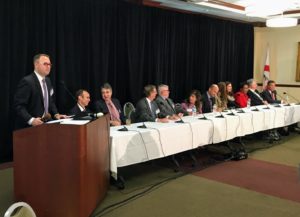How Do Courts Use Social Media?
Click this link or the picture to the right for a .pdf of the article.
Click this link or the picture to the right for a .pdf of the article.

Jared Krukar introduces the judges of the court at the 2017 Practicing Before the Second DCA CLE presented by the Florida Bar Appellate Practice Section. Photo by Kristin Norse.
The Second District Court of Appeal has long been known for its liberality in granting oral argument, but also had a discrete list of types of cases in which it would almost never do so. However, the Court recently updated its Internal Operating Procedures[.pdf] (“IOPs”) to reduce the list of exceptions and leave the judges with more express discretion.
The IOPs were last amended on October 15, 2015. In that version, the Court stated it would generally not permit oral argument in appeals in which a pro se party is incarcerated, reemployment assistance appeals, original proceedings, postconviction appeals, 9.130 final and nonfinal appeals, and motions.
The Court always had discretion to grant oral argument in any of these cases, but rarely deviated from the list.
The revised IOPs, effective as of April 12, 2018, no longer expressly exclude from oral argument original proceedings, final and nonfinal 9.130 appeals, nonsummary postconviction appeals where the parties are represented, reemployment assistance appeals, or motions.
However, the IOPs added new language that elucidates the Court will likely apply discretion on a case-by-case basis more than it has in the past:
Requests for oral argument in expedited proceedings, including termination of parental rights and dependency cases, are presented first to the merits panel. Upon the panel’s decision to grant oral argument, the clerk will set the case on an expedited basis.
Other than expedited proceedings, cases are set for oral argument prior to the assigned panel’s review. As such, the cases are provisionally set for oral argument. Should the panel of assigned judges decide unanimously that the court will not benefit from oral argument, the clerk will be directed to notify the attorneys or parties by order that the argument is cancelled. An order cancelling argument for this reason will generally issue no later than two weeks before the date of the scheduled argument.
While the current IOPs still say that “the court permits oral argument as a matter of course in most proceedings,” this new language makes clear that the Court is aware of its discretion and will inevitably use it to reject oral argument when it deems fit to do so.
Well, according to the IOPs, it now appears that one can seek oral argument in nonfinal appeals, original proceedings, and certain other cases whereas before extraordinary measures would need to be taken.
But don’t jump the gun just yet. The Second District’s “Notice to Attorneys and Parties[.pdf]” still contains a list of types of cases excluded from oral argument, and it still matches what the old IOPs said.  Presumably the Second District will be updating the notice to match the new IOPs, but for now, it governs what parties can file. Also, check out our post on the Second District’s Practice Preferences as well to be sure you’re complying with all current requirements.
If you have a case on appeal and aren’t sure whether oral argument is available, or whether it is the best option for you, contact us and ask. There are pros and cons to every decision like this, and we can help you make the right choice for you and your case.
Last week we reported that the Supreme Court of the United States went live with their new website–its first step of a modernization plan that includes e-filing. Â Yesterday, the Court set a date for e-filing to begin and provided some details.
According to the Court’s press release, e-filing will begin on November 13, 2017.  Parties will be required to file both paper and electronic copies, with the paper copy being the official copy for now (so remain vigilant with your mailing and paper filing practices!).  Pro se parties will continue to file just paper, but the Court will scan all filings to make them available on the electronic system.  That system should provide easy website access to all filed documents for public access.
Registration for the new e-filing system will begin “4-8 weeks before the system begins operation,” so keep a lookout for another press release at about mid-September. Â The Court has placed an “Electronic Filing” link in the center of its home page that it says will supply additional information, but currently contains only the text of the press release.
A recent video from the U.S. Courts shows the amazing efficiencies obtained from e-filing in other federal courts. Â Presumably the same benefits of modernization will occur in the Supreme Court. Â That said, one wonders what the new, leaner Supreme Court will look or feel like. Â We can’t help but feel a bit nostalgic for the days of paper as this bastion of traditional practice updates for the twenty-first century.
